Hydraulic seal for a well: how to properly seal cracks in concrete rings
A leak in a well can seriously affect the quality of drinking water.Through a seemingly small hole in the concrete shaft, household wastewater and technical fluids spilled on the ground will begin to penetrate. Sand will fall off from the horizons lying above the aquifer, which will negatively affect transparency. It's unpleasant, isn't it?
To restore the integrity of the well shaft, a quickly hardening composition will be required, which will allow you to quickly eliminate the defect in the concrete structure. A hydraulic seal for a well will eliminate leaks, large and small cracks forever. We will tell you how to choose it correctly.
We describe in detail the process of applying the repair composition. We offer recipes for making fillings yourself. The information is supplemented by useful diagrams, photos and video tutorials.
The content of the article:
Types of seals for hydraulic structures
Previously, before the invention of hydraulic seals, wooden boards, hemp and jute materials were used as plugs for wells. A significant drawback of outdated types was rapid delamination and decay, which led to a deterioration in the quality composition and taste of well water.
With the invention of the hydraulic seal, it became much easier to eliminate leaks and operate wells. Modern manufacturers of building materials offer ready-made waterproofing compositions based on polymer materials.
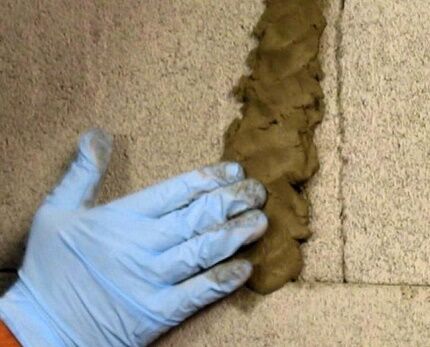
However, many well owners and professional repair teams prefer to use self-made seals, rightly believing that this will lead to cheaper repair work without loss of quality.
Hydroseals are divided into two types:
- Pressure, quick-hardening mixtures. It takes 10 to 60 seconds for them to harden. A special repair compound that has waterproofing properties is applied over such a seal.
- Non-pressure, hardening within 5-7 minutes. Such mixtures are used not for emergency work, but for preventive work, for example, planned insulation of seams.
We'll look at each option in more detail below.
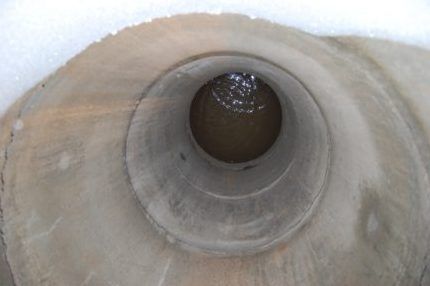
Waterproofing grouting materials (water seals) are often used in emergency cases, when the time of hardening determines how much water will run out or seep in, thus the amount and severity of damage that can be prevented depends on the quality and correct use of the water seal.
High-quality hydraulic seals can eliminate leaks in 30 seconds, stopping the flow up to 7 atmospheres!
Waterproofing seals are used in the following cases:
- to protect drinking water in a well from groundwater penetration
- plugging water breakthroughs in basements, adits, wells
- isolation of a breakthrough in places of contact of the floor, walls, between foundation blocks
- hermetic sealing of seams and cracks in wells
- express pipeline repair.
In concrete wells, a hydraulic seal serves not only for emergency repairs and elimination of leaks, but also to prevent changes in water quality in places of thinning and increased filtration.
Waterproofing seals for wells must meet the following requirements:
- reliably seal seams and cracks, creating a monolithic connection;
- be resistant to cracking and exposure to low and high temperatures;
- do not change water quality;
- set quickly;
- not be subject to deformation or corrosion;
- be easy to use.
Almost all hydraulic seals offered on today’s construction market meet the requirements described above.
Self-made seals, subject to certain rules, which we will discuss below, will also be effective and will allow you to eliminate a leak or carry out preventive work in a well. As a result of the event restoration of water quality can be done much less frequently.
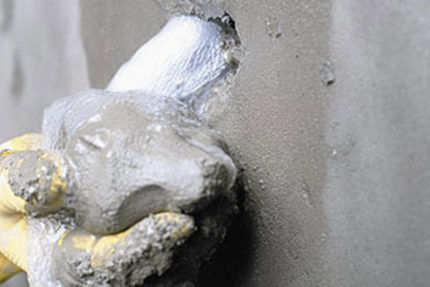
Ready-made waterproofing seals
Ready-made hydraulic seals for concrete wells are very convenient: to use such a seal, it is enough to dilute the solution with water according to the manufacturer’s instructions. Let's look at the most popular waterproofing sealing mixtures.

Option #1: water plug. This mixture contains fine-grained quartz sand, aluminum cement, and active chemical additives that give the composition plasticity and allow it to quickly harden. Using this type of seal, you can quickly eliminate a leak within 2 minutes.
The waterplug can be used at temperatures from +5 to +35 degrees. It is used in pool waterproofingc, the underwater part of bridges and similar structures. Among the disadvantages of this hydroseal is the need for dilution with warm water +20-25 degrees, which in some cases is not entirely convenient.
Option #2: peneplug. Available in the form of a dry powder that must be diluted in water. This mixture is intended for waterproofing concrete wells, as well as wells paved with brick, natural or artificial stone. The hydroseal is based on high-quality cement, quartz sand and polymer additives.
This mixture is capable of stopping a leak with a pressure of more than 5 atmospheres. Hardening time 40 seconds.
Option #3: powder ex
A fast-acting waterproofing seal that sets within 10 seconds after application. This filling has excellent characteristics: frost resistance, resistance to aggressive environments, ease of use.
The disadvantages of this mixture include high cost and the inability to work at temperatures below +5 degrees.
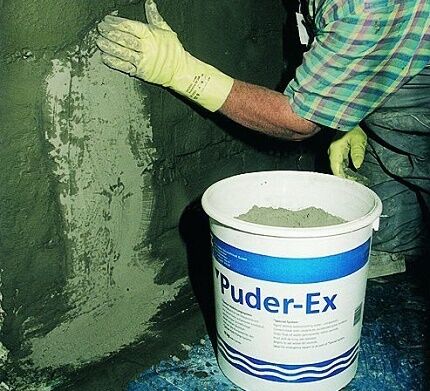
After using any chemicals to perform repair operations, well water should be returned to analysis in SES or a laboratory accredited to conduct the specified type of research. Studying the composition of the water will help to find out whether there are any sources of pollution left in the mine, or whether the repair material has affected the quality characteristics.
Technology of using ready-made compounds
Ready-made waterproofing seals are most often used to seal leaks when the water that leaks or leaks can cause serious damage.
When using ready-made hydraulic seals, it is necessary to strictly follow the work technology:
- Surface preparation. At this stage, using a perforator or hammer, it is necessary to clean the surface of the well from exfoliated concrete. However, first the surface must be cleaned of dust, dirt, and mold.
- Expansion of the repaired area. It is necessary to widen the hole by 20-30 mm and deepen the hole by 30-50 mm. This is done in order to “refresh” the edges of the hole. In this case, you should try to give the sealed crack the shape of a funnel. When sealing a seam, it is necessary to strip it and deepen it by 5-10 mm. To expand, it is best to use a wide spatula, working the damaged area from top to bottom. Small cracks and holes can be expanded in any direction as convenient for the repairman.
- Preparation of the solution. The solution is prepared no later than 2 minutes before use. Recommendations for preparation, proportions, optimal water temperature - all this must be studied before preparing the waterproofing mixture. To dilute the mixture, use a clean metal (not aluminum!) container.
- Filling the crack. We fill no more than 50-70%. This is necessary so that the waterproofing solution, which expands during the hardening process, does not damage the walls of the well.
- Stabilization of the filling. Press the finished filling with your hands for 3-5 seconds to several minutes (indicated in the instructions for use).
- Care. Depending on the mixture used, it may be necessary to periodically wet the seal over a period of 12-24 hours. If the instructions do not provide for this, then there is no need to do this.
- Treating the seal with a waterproofing compound. At this stage, a penetrating waterproofing material is used, which will protect the concrete wall of the well and the installed hydraulic seal from further destruction. From ready-made waterproofing mixtures you can choose: “Osmosil”, “Hydrotex”. Waterproofing can be applied only after the filling has completely hardened, unless otherwise provided by the manufacturer.
When diluting the solution, strictly follow the proportions specified by the manufacturer. You should not skimp and try to dilute the mixture thinner or, in an effort to increase its effectiveness, make it too thick. In both cases, the waterproofing properties of the seal will be impaired.
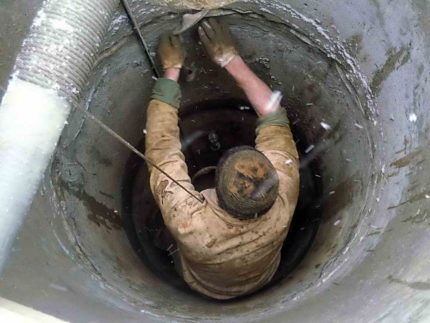
Often, along with sealing cracks, more serious damage is revealed that requires major repairs. well repair. We recommend reading information about their elimination methods.
Making a filling yourself
Self-made hydraulic seals have some features. They are somewhat inferior in quality to ready-made fillings produced by the industrial method.
These disadvantages include:
- there is no guarantee of inertia, i.e. a “homemade product” can come into contact with the environment, thereby changing its properties;
- a homemade filling hardens much slower than an industrially produced one;
- there is a possibility of the seal disintegrating and its components getting into the water.
Based on the last point, we do not recommend using toxic compounds to create “homemade” hydroseals!
The advantages of homemade seals include low cost and availability, which is especially important in emergency cases when there is no industrial seal at hand.
#1: Homemade pressure-free seal
To prepare a waterproofing seal, the following materials are needed: fine-grained, preferably sifted sand, cement of a grade not lower than M300. Proportions - 2 parts sand + 1 part cement. Immediately before use, water is added to the composition.
Water must be added gradually, stirring constantly. The consistency should be thick so that the mixture can be easily formed into a ball that will not spread.
The filling is applied to a large crack by hand, and rubbed into a small crack with a spatula. After the repair is completed, the well section must be covered with an iron plate. After 2-3 days, the iron is removed, and the filling is treated with cement mortar and covered with waterproofing.
This method can only be used to eliminate non-pressure and low-pressure leaks. Under high pressure (over 3 atmospheres), such a homemade composition is quickly washed out.

#2: Seal for seams and small cracks
Despite all their shortcomings, homemade hydraulic seals are excellent for sealing seams in concrete wells. They cope with this task “excellently”, while allowing them to save a significant amount on industrially produced products.
Being environmentally friendly and safe, homemade hydraulic seals made of sand and high-quality cement reliably protect well water from the ingress of groundwater, impurities, and soil.
To increase the efficiency of waterproofing the seams of a well, a “liquid glass” composition can be added to the solution of sand and cement. This mixture will make the sealing better and more durable. Proportions 1:1:1 (sand:cement:liquid glass). It is necessary to add “liquid glass” 1 minute before sealing, because The composition hardens very quickly!
The technology for sealing the seams of a concrete well is as follows:
- Surface preparation, which consists of removing exfoliated concrete and remnants of old sealing.
- If necessary, treat the walls of the well with an antibacterial compound to remove/prevent mold.
- Cleaning seams from dust, dirt, and old waterproofing. Expanding the seam by 5-10 mm by gating. The tools used are a hammer drill, a hammer, and a wall chaser.
- Preparation of waterproofing mixture.
- Pre-wetting the seams. The seam should not be wet, but moistened. It is optimal to use a fabric that absorbs water for this procedure.
- Applying the waterproofing mixture using a spatula. Filling cracks and caulking joints.
- Application of a penetrating waterproofing solution.
How often are seam waterproofing works carried out? Waterproofing the seams of a concrete well is carried out on average once every 5 years, provided that the well is operated correctly. Emergency waterproofing is carried out in the event of a leak, deterioration in the quality of well water, or after sudden drainage.
It is best to carry out waterproofing work in the spring, after the snow has completely melted, when the average daily temperature is no lower than +5 degrees.
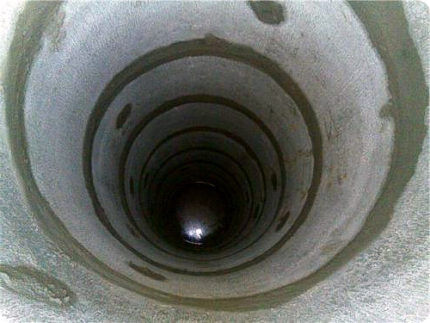
Safety precautions for working in a well
Work to eliminate a leak or seal a well is a high-risk activity, so it is necessary to strictly follow safety requirements.
At the preparatory stage, you should carefully handle a jackhammer or hammer drill, which is used to clean the surface from peeling concrete and chips.
When mixing the hydroseal, you must protect your hands with thick rubber gloves. The tool used to apply the hydraulic seal must be cleaned immediately after completion of the work of any remaining waterproofing mixture.
When using ready-made hydroseals, make sure that the composition does not get on exposed skin. When diluting the powder, try not to inhale the resulting vapors, as they can harm the mucous membrane.
Selection of the optimal hydraulic seal
Industrial or home-made waterproofing seals are a simple way to eliminate pressure or non-pressure leaks in a well. The technology for using hydroseals is very simple; even a non-specialist can waterproof a concrete well.
When choosing a method for eliminating a leak, pay attention to its characteristics: we recommend eliminating pressure leaks using ready-made, quick-hardening hydraulic seals.
You can eliminate non-pressure leaks, as well as waterproof the seams inside the well, using self-made hydraulic seals. The use of homemade hydraulic seals is only possible in a dry well, because... the available water will wash the solution before it hardens.
The list of well maintenance activities includes not only repairs. Much more often it is necessary to carry out well shaft cleaning, the methods and features of which are described in detail in the article we propose.
Conclusions and useful video on the topic
The video will introduce you to the procedure and technological stages of sealing joints in a concrete well:
Detailed video instructions on eliminating pressure leaks using a Peneplag hydraulic seal:
Proper production of handmade seals and the use of industrial compounds guarantees an excellent result and will eliminate leaks and cracks in a reinforced concrete well shaft.
We are interested in your personal experience in eliminating leaks in a concrete well shaft. Please write comments in the block located under the article presented for review. Here, ask questions, share useful information and photos of the process of sealing cracks and weak spots in the well shaft.




I sealed the well with peneplug (I couldn’t find anything else in the store, and nothing good worked with the homemade one). I liked the quality, it sets really quickly, so you need to knead in small quantities and follow the instructions in proportion. And so, this is the work of a couple of hours and at least two people, there is nothing complicated about it. The well must be maintained and its condition periodically checked.
This peneplug is too expensive for the price. I don't think it's worth such a big overpayment. I used Waterplug, which is about half the price, and does the job quite well. Seals firmly and quickly. And I don’t see any inconvenience in taking a thermometer in advance and measuring the temperature of the water before making the mixture so that it is about +20.
I used WDM waterproofing, an analogue of Penetron.The material performed very well and is much cheaper!!! I recommend